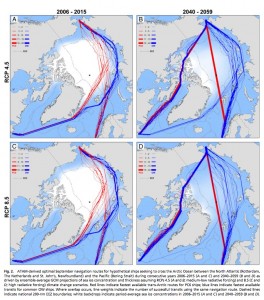
Arctic shipping could be possible for unescorted, open-water vessels by mid-century.
“This research quantifies for the first time the speculations that have been buzzing around for a number of years now,” says Laurence Smith, a geographer with the University of California, Los Angeles.
Smith and a fellow geographer modeled Arctic shipping routes using climate change models, and navigation rules. The results show that by 2040, light icebreakers will be able to go pretty much anywhere in the Arctic Ocean during the late-summer melt season, including straight over the North Pole.
“And open-water vessels are able to, definitely able to, cross through the Northern Sea Route over Russia, and increasingly through the Northwest Passage as well,” Smith says.
Right now, there’s almost no commercial shipping through the Northwest Passage, and vessels transiting the Northern Sea Route need an icebreaker escort. But both routes cut thousands of miles off the standard journeys through the Suez or Panama canals, and the ability to travel unescorted could make them increasingly attractive to shippers. Smith says that should concern policymakers in the region.
“The Arctic is a very remote place, a very dangerous place, always will be. The ice will always come back in winter, it’s dark, the charts are poor, and ordinary open-water ships make up the vast majority of ships on Earth.”
And the day when open-water vessels can make the journey may be coming even sooner than Smith’s models predict. The climate change models he used assume incremental change between now and 2040, but Smith says real-world satellite observations tell a different story.
“The rate of sea ice decline in the Arctic is actually shrinking even faster than even our most aggressive models, so the outcomes of this study should be considered conservative.”
With shippers eager to know when the routes will become commercially viable, Smith says his next project is to expand the study from just September to all twelve months of the year.
You can read the full paper here.




